
|   |

|   |
Manipur Diary Bhagyachandra National Festival of Classical Dances 2011: Edition IX - Dr. Sunil Kothari e-mail: sunilkothari1933@gmail.com Photos: Avinash Pasricha November 26, 2011 When the renowned theatre director of Chorus Repertory Theatre, Ratan Thiyam called me at Delhi from Imphal two months ago to block my travel dates from 9th till 14th November, for the IXth edition of Bhagyachandra National Festival of Classical Dances 2011, I was delighted for the very reason that on 10th November, it would be Kartik Purnima and we would be able to witness in Shri Govindajee temple in Raas Mandap, Maha Raas being staged specially as a tradition on the full moon night. I have visited Imphal from 1958 some half a century ago, and then from 1966 repeatedly, as I was fascinated by the Manipuri dances, having seen in Mumbai the Jhaveri Sisters, who as non-Manipuri exponents of Manipuri dances, have contributed immensely to its popularity. Being closely associated with them for as many years, my very first visit in November during the month of Kartik, I was fortunate to witness Maha Raas, and have distinct memory of more than fifty dancers, dressed in red mirrored skirts, their faces covered with gossamer veils, with gold coloured ornaments and velvet green, red blouses, moving like swans in the temple courtyard! I had written to my devout Vaishnav mother and Jhaveri Sisters that it looks like I have come to Gandharva Lok, a celestial region. All this as a result of my purva janma punya (the blessing of my previous birth), else how can one be so fortunate to have glimpses of this dream like vision of a ruler by name Bhagyachandra ,who dreamt about Lord Krishna playing Raas with the gopis, in colourful costumes, at a place called Kaina, some 29 kilometers away from Imphal and associated with the Meitei King Meidingu Chingthangkhomba, popularly known as Rajarshi Bhagyachandra who created Maharaas and gave it to the world in the late 18th century AD. Historically his rule is ascribed to 1759- 1798 AD. Legend has it that it was at Kaina Hillock that the jackfruit tree was found. In the dream Lord Krishna asked Bhagyachandra to create out of the wood of the jackfruit tree, the image of the Lord which was installed in Shri Govindajee temple. 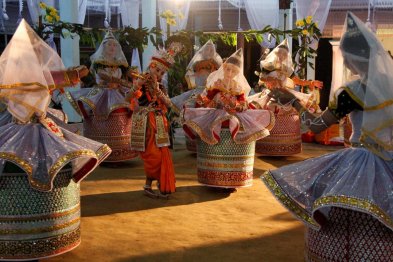 Raas at Kaina village 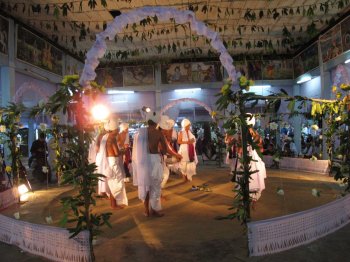 Raas at Kaina Village An area covering 22 x18.40 sq m. including the temple complex and its immediate surroundings are protected by the Government of Manipur under the provisions of Manipur Ancient and Historical Monument and Archaeological Sites Remains Act 1976. We were taken by a van through hilly terrain in a bumpy ride to the site, decorated with white in ascending order, spotless white circular festoons, beautiful umbrellas, mud pots with bananas. The Raas Mandap was decorated with white decorations, full of well carved designs. Inside the Mandap was a circular space with arches decorated with mango leaves and flowers. The Maharaas was to take place there around 2.30 pm when the Chief Minister of Manipur Mr. O. Ibobi Singh inaugurated the festival. He arrived with 'black cats' security and we were with Mr. B.M. Bakshi, the Director of Doordarshan Kendra, New Delhi. Bakshi lamented that in our democracy, the CM has to come protected by black cats' security to inaugurate a religious ritual performance! Mr. Bakshi told us succinctly that there are five Ts - Telecom, TV, Tourism, Terrorism and Tension that govern our lives!! Twenty two years ago when the first edition of Bhagyachandra Dance Festival was held at Kanchipur (in Imphal), another sacred place near Imphal, the magic and impact of it were so intense that we recalled with a feeling of nostalgia and our sense of awe. Ratan has designed the setting for Raas Mandap with great imagination. A devotional spirit pervaded the atmosphere. The traditional Nata Sankirtan by all male dancers, two pung players, and the nine to ten cymbal players, sang about Lord Krishna, as described by Chaitanya in Gaura Chandrika, going to graze the cows, presumably in Metei language. Their white attire, pugree and circular movements, brass cymbals with red tassels and its sound when played, along with the frenzied playing of the two pung players, the leader and the accompanist Duhar, mesmerized us. All Raas performances are preceded by Nata Sankirtan. Of the five Raas - Basant Raas, Nitya Raas, Kunja Raas, Diva Raas and Maha Raas - Basant, Kunj and Maha Raas are attributed to Bhagyachandra maharaja. Earlier, Maha Raas was staged for five consecutive nights, culminating in full moon night of Hiyangei (Kartik month). It is said that Bhagyachandra's daughter princess Bimbavati took the role of Radha and performed in Maha Raas. 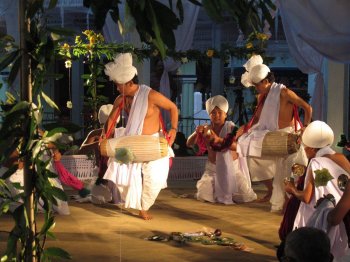 Raas at Kaina Village 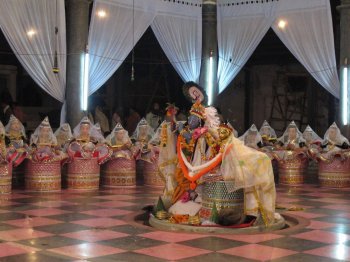 Raas at Govinadajee Temple The theme and sequences of Maha Raas are based upon the Dasham skandha (tenth canto) of Raas Panchadhyayi of Shrimad Bhagavata Purana. The shlokas are recited by the sutradhari singers and the gopis request Lord Krishna to dance with them in Maha Raas. Nowadays, the way they are rendered, it is difficult to comprehend. I also understand that nowadays the shlokas and its translation are rendered into Meitei. Manipuri music is an independent school of music, so very different from the two well established Hindustani and Carnatic music traditions. The Nata Sankirtana performed at Kaina was by Shri Hari Nata Sankirtana Academy, led by Keishamthong Maning Longjam Leikai Nupa Pala group of Imphal. After the Nata Sankirtana, the Maha Raas followed with bringing Lord Krishna in a simhasana and placing him in front of the small temple. The sutradharis sang shlokas from Shrimada Bhagavata. With Krishna abhisara (Krishna's dance), the Raasleela began. Then various gopis entered the mandap with chowris (fly whisks) and waved it before child Krishna and prayed to him to perform raas with them. The five bhangi parengs, the basic movements of Manipuri dance, I understand, are performed during the Maha Raas. We were told at Shri Govindajee's main temple where Maha Raas was performed, all the expenses for the performance were underwritten by a devotee and besides professional dancers, others also join. A large number of dancers, more than 60, were seated in their stiff circular mirrored skirts round the mandap. One lead dancer performed round the installed images of Lord Krishna and Radha, in the centre, on a revolving wooden disc, which was manipulated with strings and turned in all directions wherever the lead dancer performed facing the deities. I had not seen this device being used earlier in other Raasleelas. One of the young male dancers explained to us that the ashta sakhis (eight gopis) would pray to the Lord and request him to perform Maha Raas with them. The vachikabhinaya, the request made by the gopis, was recited by the gopis and supported by the sutradharis. Once the lead dancer completed her rounds, the other gopis got up and formed a larger circle and started performing. We were told that when Krishna and Radha leaving gopis in the mandap, disappear, the lights would be switched off to suggest the disappearance of Krishna and Radha. At this the gopis start searching for Krishna and beg his forgiveness for their own ego, and surrender to the Lord. Then Krishna would appear taking multiple forms dancing with each gopi recreating the exquisite sight of the shloka “anganam anganam antare Madhavo”; between each gopi there would be Krishna and they would dance in ecstasy. There are excellent pichhwai paintings showing Maha Raas sequences. Those visuals would all come alive. The Maha Raas concludes around 2 am in the morning. However, nowadays at Shri Govindajee temple they only sing those stanzas, but several Krishnas do not appear, whereas at other places or on a metropolitan stage when excerpts of Maha Raas are presented, in the finale we see several Krishnas and gopis performing as a climax. On account of insurgency and state of disturbance, the streets at night are deserted in Imphal. For security reasons, the security guards were seen everywhere. We were asked to return to the hotel as it was past 11 pm and we left wanting to see more and learn more about the other sequences of Maha Raas. We wished there were some of the dancers from Jawaharlal Nehru Manipuri Dance Academy to explain to us more as the singing was in Meitei language. But we were told that on account of the present unsettled conditions, few dancers attend or move out after 8 pm. It is almost like a curfew in the city. Perhaps because of that, photographer Avinash Pasricha, Leela Venkatraman, dance critic for The Hindu, and I did not experience the intensity we had twenty years ago when we witnessed Nata Sankirtana and Maha Raas at Kanchipur where they were specially staged for first Bhagyachandra Dance Festival. The elders in Imphal also lamented that the young generation of late was not showing enough interest and respect for the tradition. 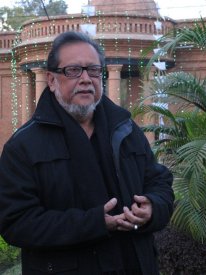 Ratan Thiyyam at Kangla 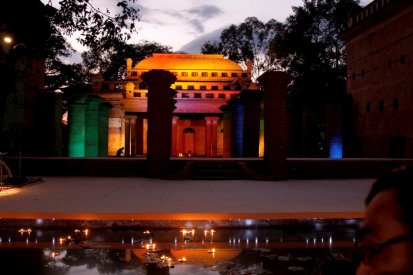
On 11th November, the Governor H.E. Gurbachan Jagat inaugurated the festival. Held at the archaeological site of the old palace of Maharaja Bhagyachandra at Kangala, Ratan Thiyam had transformed the place into a dream world. The pillars, Shri Govindajee's temple flanked by two towers, and the space between the stage and in front the water body reflecting the dancers were imaginatively designed by him in keeping with his fame as a brilliant designer. The tiered seating arrangement in the open and the full moon above in the sky were a perfect setting for classical dance forms. The note about Kangla reads as follows: 'Kangla is a legacy of the Manipuri Kings. They ruled at Kangla since the first century A.D. up to the 19th Century A.D. Manipuri kings ventured as far as the kingdoms of Siam, Ava, and the hill tracts in the north bordering the mighty Chinese Empire. Kangla is a revered holy place of the Manipuri… When the British forces occupied Kangla in 1891, much of the structures within the fort were severely damaged. The temple, Beithab, Brindabanchandra temple, wall portion of citadel and the steps at Uttara survived the destruction… Kangla indicates the martial character of Manipuris, while also showcasing the religious temperament of the people.' With such a backdrop, no wonder the performances appeared to have an extra dimension. The opening number Mangalacharan by leading Manipuri dancer Ibemubi Devi of Jawaharlal Nehru Manipuri Dance Academy, with typical Manipuri singing and musical accompaniment created the mood of devotion. Gita Govinda being most favoured dance numbers, she performed “Yahi Madhava Yahi Keshava” ashtapadi depicting khandita nayika employing angikabhinaya, the salient features of expression in Manipuri dance, interspersing with nritta (pure dance), bhramaris, pirouettes, soft movements of hastas (hand gestures), embellishing the dance with natural grace and complete command over tala and laya. A seasoned dancer, she also presented her favourite choreographic piece from Kalidasa's Ritusamhara, dwelling upon the Grishma season with Kalidasa's inimitable poetry “Nidagha smaya samupagata priya” - the summer has set in O beloved. The utterances had the pain, mixed with joy of being with the beloved. The alankaras (figures of speech) used by Kalidasa, find felicitous expression in description of the nature. The version indeed had the indelible Manipuri stamp. 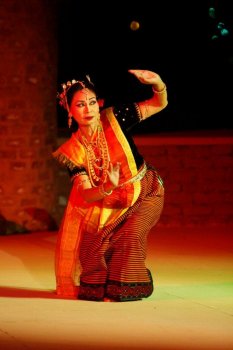 Manipuri by Thokchom Ibemubi Devi 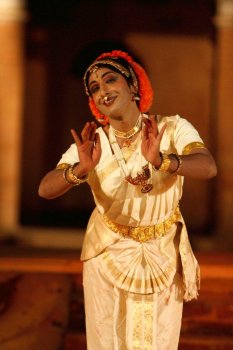 Kuchipudi by Vedantam Venkata Naga Chalapathi Rao From Kuchipudi village Vedantam Venkata Naga Chalapathi Rao, popularly known as Venku, with his equal command over female impersonation and male characters, performed Thyagaraja's stuti in praise of Ganapati in female attire, followed by enactment of Satyabhama in a conventional patra pravesha daru, introducing the character from behind the curtain, from Bhama Kalapam based on Parijatapaharana play, displaying haughty temperament, pride, sauciness, being none else than daughter of King Satrajit, beloved of Lord Krishna. The feminine grace was at the beck and call of Venku. Another song from Bhajana Sampradaya about Krishna's playing flute in Brindavan and its impact upon birds, animals, waters of Yamuna, trees, creepers, the dancing peacock was melodious and full of verve and joy, bringing out the inherent quicksilver quality of Kuchipudi movements. In male impersonation, Venku with quick change of costumes danced Dashavatara with speed and with perfect synch of tala and laya. In spite of druta (fast paces), the iconographic images of each incarnation was presented with hastas, which left indelible impression. The references to Parasurama, Balarama were befitting the temperament of the mythological characters. For want of time he could not present a heroic character like that of Hiranyakashipu, in which he excels and succeeds in his abhinaya of male characters contrasting with female impersonation.
From Guwahati, Anita Sharma, a disciple of Jatin Goswami, in quintessential slow movements performed prayer and followed it with an abhinaya piece from Madhavadeva's Bargeet, Yashoda awakening Lord Krishna and asking him to go to graze the cows. The description of early dawn, the birds flying and Yashoda's vatsalya (motherly love) for child Krishna was imbued with devotional fervour. From the repertoire of Sattriya dances, Rajghariya chali, with emphasis on pure dance was embellished with several phrases. Anita concluded her presentation with episodes of Gajendra Moksha based upon Shankaradeva's composition from Kirtanaghosha. The way Gajendra, a devotee of Lord Vishnu, luxuriantly playing in waters, is caught unawares by the crocodile and prays to god to save him had enough of dramatic impact. Lord Vishnu astride his vehicle Garuda, sends Sudarshan chakra (the disc) and the crocodile is killed. Gajendra offers lotuses to Lord Vishnu. On a quiet devotional note the performance ended. From among the accompanying musicians, Bhaskar Jyoti's playing on the khol was in keeping with various moods and his mastery over the percussion lent an extra dimension. Prashanta Rajkhowa's vocal support was full of bhava. Elam Indira Devi, a post graduate form Jawaharlal Nehru Manipuri Dance Academy was the last artiste. She has extensive experience in Lai Haraoba and Raas dances and has been performing nationally and internationally. Versatile, scholar and a performing artiste, she has authored a book Laiharaoba Wakhallon Paring and is also a guest lecturer at the UGC Academic Staff College at Manipuri University. Unfortunately, I could not see her presentation which indeed is my loss. Imphal has been going through lot of trouble with blockades of roads and supply of essential food, fruits and most importantly shortage of fuel. There was tension in the air and the organizers were worried if the festival would continue. Fortunately the decision was taken to continue the festival and crowds turned up in large number. Avinash Pasricha, Leela Venkatraman and I were interviewed for Doordarshan and were asked to give our impression of the dance festival when it started 22 years ago and the present state. We all expressed our worries about loss of interest among the young generation in classical dances on account of the political disturbances and worsening economy. Though we believe that arts sensitize the people and in Manipur, music and dance are a part of one's life, the prospect of promoting arts in face of various unsettling factors indeed poses problem. It is a miracle that the present government has mustered enough courage to mount the national dance festival despite all troubles. We hope performing arts would restore confidence among people about its need as a means to inculcate among young, the values of life. From Bhubaneswar late Guru Gangadhar Pradhan's disciples Ramesh Jena and his wife Madhusmita Mohanty offered a delectable Odissi fare. Beginning with Shankaracharya's Jagannathashtakam, they built up the mood, drawing the chariot of Lord during Rath jatra, singing “Jagannathaswami Nayanpathgami bhavatu me...” Their duet dancing was complementary and there was uniformity in their execution of pure dance movements and various amorous poses in expressional numbers. Guru Debaprasad Das's thai nach with sabdaswarapath has a haunting quality. Its inclusion in their repertoire is welcome for the simple reason that it lends a touch of variety in their presentation. Ashtapadi from Gita Govinda in which Krishna requests Radha to join him in the kunj (bower) where he has prepared a flower bed was replete with appropriate shringara rasa. Set to music by Subas Pani, distinguished connoisseur and an authority on Gita Govinda and Oriya culture, the couple did justice to the less known and rendered ashtapadi. Concluding the recital, they presented Navarasa to select episodes from Ramayana, as a peg to play around the bhavas, resulting into the rasas. The episode of Shurpanakha for hasya (laughter), monkeys building the bridge, 'setubandha between Sri Lanka and Bharat,' disgust at seeing the dead bodies of soldiers and vultures eating their flesh, fierce anger (raudram) at killing Ravana and so on received applause from the audience. The musical support was of their customary finesse. 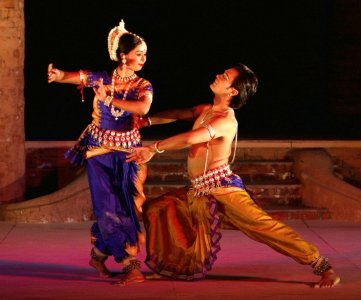 Odissi by Madhusmita Mohanty & Ramesh Chandra Jena 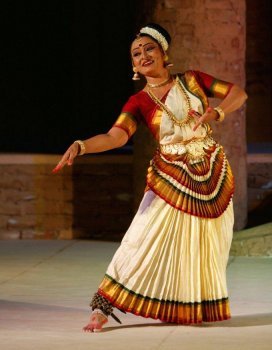 Mohiniattam by Pallavi Krishnan Pallavi Krishnan from Thrissur presented Mohiniattam. Trained at Viswa Bharati (Shantiniketan) and Kerala Kalamandalam, Pallavi has imbibed the feminine Kerala dance form admirably. She has a fine stage presence and sound understanding of the form. After prayer in praise of Lord Shiva, she presented excerpt from poet Kalidasa's Vikramorvashiyam, centering round Pururava and celestial nymph Urvashi. I wish the narrative and sequences were explained in a little more detail to comprehend the action. In terms of nritta and abhinaya, with a mobile visage Pallavi registered bhavas competently. The impersonation of Pururava and Urvashi were handled well. Rather than presenting the usual Swati Tirunal compositions, Pallavi chose classic of Kalidasa. “Dhun sunan ke nach rahi gori,” a Swati Tirunal tillana in Dhanyasi was quick paced and had touch of familiarity… enjoyable performance. The musicians gave her excellent support with specific Sopanam music. I was indisposed and therefore could not attend the rest of the performances by Bharatanatyam dancer Vani Ganpathy, and the local Manipuri dancers. The festival was a huge success in spite of the disturbed political situation and late hours. The crowds lustily cheered Rajendra Gangani's Kathak performance. A brilliant Kathak dancer of Jaipur gharana, Rajendra Gangani has earned fame as a gifted dancer from the young generation.The enthusiasm displayed by audience was heartwarming. 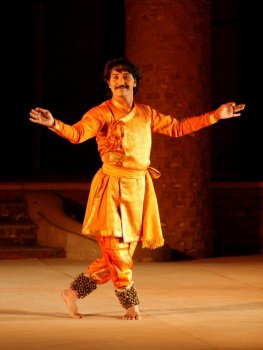 Kathak by Rajendra Gangani 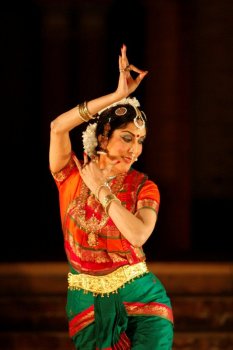 Bharatanatyam by Vani Ganapathy The organizers, Dept. of Art and Culture, Govt of Manipur, EZCC, Kolkata, NEZCC, Dimapur deserve compliments for organizing the festival at this absolutely amazing historic place at Kangla, where Ratan Thiyam creates a setting of extraordinary beauty. Since the festival takes place at interval of three years, one feels fortunate to savour its beauty when invited to attend it. Manipuri dances have won fame world over with its aesthetic beauty and so have people of Manipur been endowed with high aesthetic culture.  Dr. Sunil Kothari is dance historian, scholar, author and a renowned dance critic. He is Vice President of World Dance Alliance Asia Pacific India chapter, based in New Delhi. He is honored by the President of India with Padma Shri, Sangeet Natak Akademi award and Senior Critic Award from Dance Critics Association, NYC. He is a regular contributor to www.narthaki.com and is a contributing editor of Nartanam for the past 11 years. Post your comments Pl provide your name and email id along with your comment. All appropriate comments posted with name and email id in the blog will also be featured in the site. |